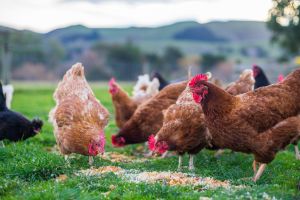
When it comes to what you eat, it seems that the more options that come on the market, the more confusing it is to know what is and what’s not good for you. With so many labels from organic to non-GMO to cage-free to pasture-raised, it’s hard to know what all of the labels mean, and why you should even care about the differences. However, there is a purpose behind these labels, to help you know more about the food you’re consuming and to help you make the right decisions for you and your lifestyle.
Two terms that may be of interest if you consume eggs will be “cage-free” and “free-range.” You may see these on the egg cartons and not have paid much attention to what they mean, but they do have different meanings, and depending on your preferences, you may find that you want to shop one over the other.
Cage-Free
Cage-free is a term regulated by the USDA, which essentially means that the eggs come from hens that aren’t caged, they can roam freely around a building or enclosed area and they have access to unlimited food and fresh water, but do not have access to the outdoors. There are a few drawbacks to this in that cage-free facilities tend to have more hen-on-hen violence and lower air quality than those that use cages. However, you can feel better that the hens have a better life not filled with cages and having the space to go wherever they want within the facility.
Free Range
Free-range is another term regulated by the USDA, and it essentially means that the hens have some access to the outdoors. What this doesn’t mean is that they are outdoors most of the time or that they do go outdoors. It is a very loose term and could mean something as little as that there is a door to the outdoors that a farmer can at some point, leave open for the hens to go in and out if they choose to do so.
Free-range is one of the more confusing terms when it comes to eggs because it sounds like they are roaming outside quite a bit of their time, but that isn’t necessarily the case and entirely depends on the farm they are raised as well as the hens. Some farmers may ensure that the hens are going outside during the day, whereas others may not have the time to notice if they go out for an hour or two.
So which is better, cage-free or free-range?
Neither is inherently better or worse than the other, it’s more of a personal preference as to which one you would prefer to have. Both allow the hens to wander around without sitting in cages all day, which is a much better choice for the hens' safety and happiness as well as for the eggs that will be laid from happy and healthy hens.
Cage-free means they can likely wander a large area, but without access to the outdoors, they are limited in their exposure and in their lives, which to some, maybe enough for them to shop free-range chickens instead. Cage-free hens generally can exhibit natural behaviors, such as nesting, foraging, and roosting. This allows these hens to be more natural with how they act and lay eggs, which should aid in happiness levels in the hens.
Depending on the program followed, free-range hens may have a large outdoor space and need to be outside for at least 8 hours a day, whereas others it’s only 6 hours a day and even others that have no time specification on how long they need to be outside. All of this can give farmers quite a bit of leeway with what the hens get as far as outdoor time, which may affect some people choosing free-range over another variation of an egg.
Both cage-free and free-range are common labels to see on grocery store shelves, and both have their pros as well as their cons. As for which one is best for you and your family, that is a personal choice and what you feel is best. Some people think the hens need outdoor time and if that’s the case, free-range is much better than cage-free. However, some feel wandering around a large enclosure is plenty for them, as they are allowed to act naturally, and they are fine purchasing the cage-free variety.

